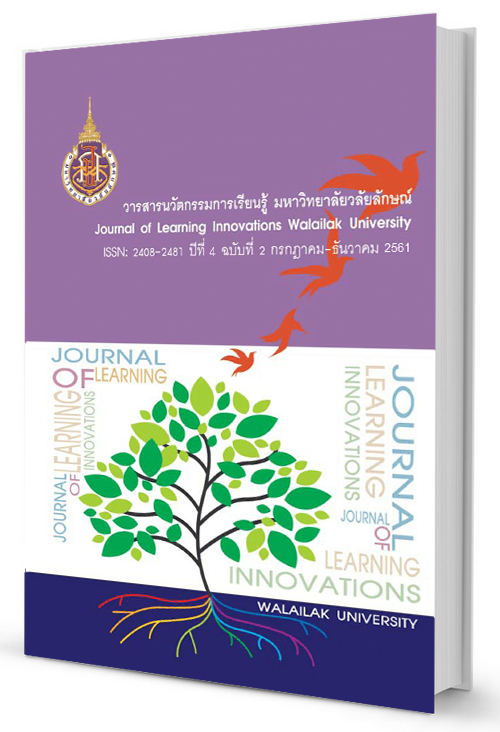Using Mind Maps to Reinforce the Student Understanding of Quantum Chemistry
DOI:
https://doi.org/10.14456/jli.2018.11Keywords:
Mind Map, Systematic Thinking Skill, Active Learning, Quantum ChemistryAbstract
Systematic thinking skill is an important skill for the learners. This skill is very necessary for the advance and complex course that needs to link all contents in the course together. However, the systematic thinking skill can be developed by using a mind map. In this research project, the mind map was applied to develop the systematic thinking skill of the learners who enrolled in CHM-331 Physical Chemistry II. The major content of this course is quantum chemistry which consists of complex topics. Moreover, these topics need to be linked together. The thinking and cognitive skills of learners were assessed before creating a mind map by answering the questions at the end of the lecture. Then, learners were assigned to make the mind maps in order to develop their systematic thinking and cognitive skills. The evaluation of the skills development was studied through the midterm and final exams. The research results show that learners lack the systematic thinking skill and cannot process the learned knowledge for answering of the questions after the lecture. After the mind map is created, the learners can improve and develop their systematic thinking skill. They can answer the questions with well-organized key points and link the relative contents for making the perfect explanation of the answer. Additionally, learners who can create the well-organized mind map, will result in a high score in the exams as well. Therefore, using the mind map is an effective and uncomplicated technique to develop the systematic thinking skill of the learners in the topic of quantum chemistry. Furthermore, leaners can understand the content of this topic thoroughly.
References
Trilling, B., Fadel, C., (2009). 21st Century Skills: Learning for Life in Our Times.
Keleş, Ö., (2012). Elementary teachers’ views on mind mapping. International Journal of Education, 4(1), 93-100.
Kokotovich, V., (2008). Problem analysis and thinking tools: An empirical study of non-hierarchical mind mapping. Design Studies, 29, 49-69.
Noonan, M., (2013). Mind Maps: Enhancing midwifery education. Nurse Education Today, 33, 847-825.
Buzan, T, Buzan, B. (1995). The mindmap book. London: BBC Books.
Omers, M.J., Passerini, K., Parhankangas, A., Casal, J., (2014). Using mind maps to study how business school students and faculty organize and apply general business knowledge. The International Journal of Management Education, 12, 1-13.
Moyses, D.D., Rivet, J.L., Fahlman, B.D., (2010). Using Concept maps to teach a nanotechnology survey short course. Journal of Chemical Education, 87(3),
285-290.
Adodo, S.O., (2013). Effect of Mind-mapping as a self-regulated learning strategy on students’ achievement in basis science and technology. Mediterranean Journal of Social Science, 4(6), 163-172.
Selvaratnam, M., Canagaratna, S.G., (2008). Using problem-solution maps to improve students’ problem-solving skills. Journal of Chemical Education, 85(3), 381-385.
Francisco, J.S., Nakhley, M.B., Nurrenbern, S.C., Miller, M.L., (2002). Assessing student understanding of general chemistry with concept mapping. Chemical Education Research. 79(2), 248-257.
Stensvold, M., Wilson, J.T., (1992). Using concept maps as a tool to apply chemistry concepts to laboratory activities. Journal of Chemical Education, 69(3), 230-232.
Nicoll, G., Francisco, J., Nakhleh, M., (2001). An investigation of the value of using concept maps in general chemistry. Journal of Chemical Education, 78(8), 1111-1117.
Downloads
Published
How to Cite
Issue
Section
License
เนื้อหาและข้อมูลในบทความที่ลงตีพิมพ์ในวารสารนวัตกรรมการเรียนรู้ มหาวิทยาลัยวลัยลักษณ์ ถือเป็นข้อคิดเห็นและความรับผิดชอบของผู้เขียนบทความโดยตรง ซึ่งกองบรรณาธิการวารสาร ไม่จำเป็นต้องเห็นด้วย หรือร่วมรับผิดชอบใดๆ
บทความ ข้อมูล เนื้อหา รูปภาพ ฯลฯ ที่ได้รับการตีพิมพ์ในวารสารนวัตกรรมการเรียนรู้ มหาวิทยาลัยวลัยลักษณ์ ถือเป็นลิขสิทธิ์ของวารสารนวัตกรรมการเรียนรุ้ มหาวิทยาลัยวลัยลักษณ์ หากบุคคลหรือหน่วยงานใดต้องการนำทั้งหมดหรือส่วนหนึ่งส่วนใดไปเผยแพร่ต่อเพื่อกระทำการใดๆ จ้อต้องได้รับอนุญาตเป็นลายลักษณ์อักษรจากวารสารนวัตกรรมการเรียนรู้ มหาวิทยาลัยวลัยลักษณ์ก่อนเท่านั้น


